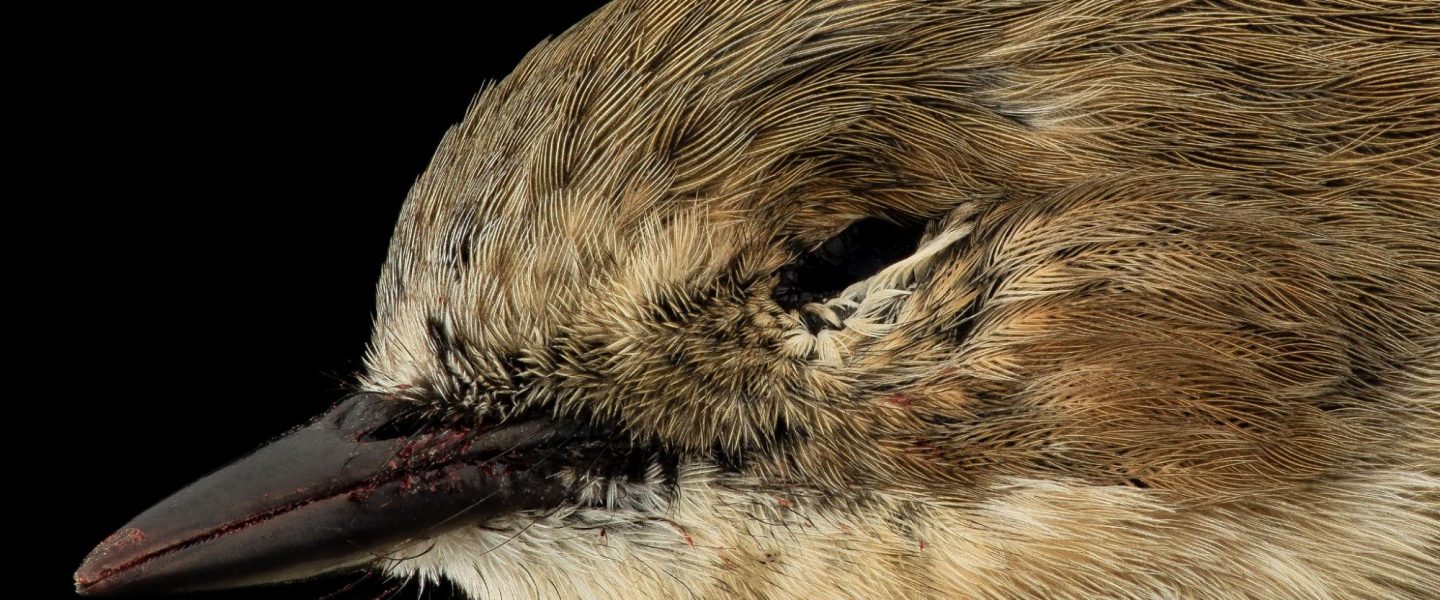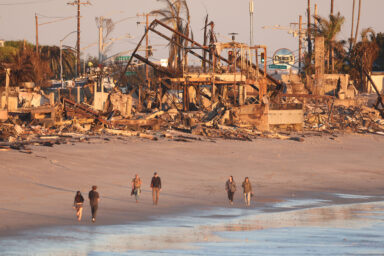Bird populations are crashing. City lights are a major culprit. But ‘Bird City Certified’ San Antonio isn’t dimming its downtown — it’s turning on the River Walk’s holiday lights two weeks early.
|
Listen To This Story
|
This story by Greg Harman & Marisol Cortez originally appeared in Deceleration and is republished here as part of Covering Climate Now, a global journalism collaboration strengthening coverage of the climate story.
It was spring migration, and millions of birds from across Mexico and Central and South America were chugging north along their annual route. Then, on the night of May 3, 2017, after days laboring over the open waters of the Gulf of Mexico, an untold number hit a storm at the Texas coast. Galveston Island’s 23-story American National Insurance Co. building, the island’s largest, provided a beacon impossible to ignore. For hundreds of songbirds known to navigate by the faint light of stars, those dazzling artificial lights likely generated a sense of disorientation, leading them to spiral out of the sky. In the morning, employees found their scattered, broken bodies by the dozens — nearly 400 in all, once tallied — around the property.
Response was swift. The building owners announced they were shutting down their exterior lights for the remainder of migration season, and efforts to create an “early warning system” for building managers were soon in development. The tragic event helped elevate a national campaign known as “Lights Out,” which has long urged cities, businesses, and individuals to turn off their lights at night during these critical times of the year.
https://twitter.com/HoustonAudubon/status/860236495407525888
Armed with improvements in radar tracking of large bird populations, researchers at the Cornell Lab of Ornithology began looking more closely at urban lighting. Between 100 million and 1 billion birds die each year in building strikes in the United States. In 2019 they published their findings in Frontiers in Ecology and Environment and later released a list of 126 US cities ranked by the threat they posed to migrating birds. The team compared the proximity of cities to major flyways and the density of historic bird traffic captured on radar with the light pollution in each respective city as seen on satellite imagery. They called out the most critical cities in a press release quoting Kyle Horton, one of the study’s authors:
“Chicago, Houston, and Dallas are uniquely positioned in the heart of North America’s most trafficked aerial corridors. This, in combination with being some of the largest cities in the US, make them a serious threat to the passage of migrants, regardless of season.”
But Houston and Dallas were not alone among Texas cities in the risks they pose. Nationally, San Antonio ranks as the 10th worst city during spring migrations, when birds travel north in denser groupings, and 14th when the Cornell team calculated fall migration travel patterns. Austin scores high also: 18th in the spring and 27th in the fall. But where Houston, Dallas, Austin, and other cities advanced changes to downtown lighting practices roughly 20 years after the first program got underway in Chicago, San Antonio has not yet implemented a similar change to lighting policies.
“This project is not something that the Center City Development & Operations Department has been a part of,” city spokesperson Kelly Saunders said of downtown operations and Lights Out.
Not only does the City of San Antonio have no plans to dim lights for the birds, this coming weekend they will flip the switch on 100,000 River Walk holiday lights two weeks earlier than usual. This move edges into the final days of fall migration, which generally lasts into middle to late November. (Lights Out, likewise, runs through November 30 for fall migration.)
It was a strange decision not only because of what researchers already know about bird strikes but also because the mayor and city council only a year ago passed a resolution recognizing World Migration Day — an act that helped secure San Antonio’s approval by Texas Parks and Wildlife as a “Certified” Bird City. But while San Antonio may be following the Bird City script, some of its actual policies — this delay on lighting, coupled with more direct attacks on migratory birds and bird habitat — suggest the bestowed laurels should be worn uneasily.
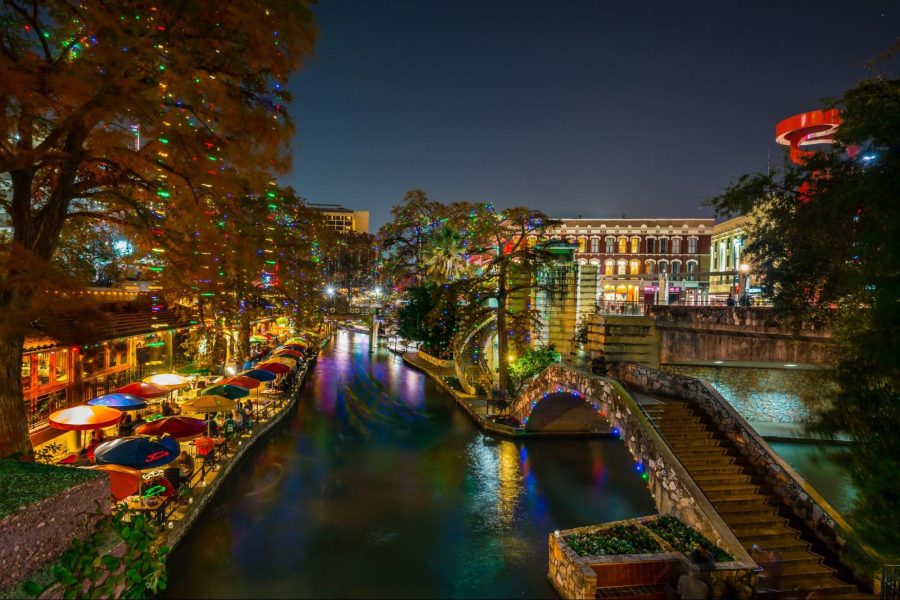
‘Bird City’ Tourism
City Councilmember Manny Pelaez makes birdhouses in his spare hours. Some of these creations he has sent to council colleagues as gifts. He also likes to photograph birds. From a councilmember who once pledged his vote on a local climate plan to the city’s largest oil and gas company (but gave an impassioned plea for biodiversity protection on its eventual adoption), these hobbyist revelations from a discussion preceding a December 2020 vote recognizing World Migratory Bird Day (WMBD) may have caught some by surprise. An air of celebration marked the action as roughly half of the council members stepped up to offer Zoom testimony in support prior to the vote.
Pelaez, whose law firm specializes in helping commercial property owners collect insurance dollars for damages sustained from weather-related disasters, went to bat for the birds.
“What a lot of us love about San Antonio is that we just happen to be located smack dab in the middle of a major migratory bird flyway as well as the migratory butterflies that all of us celebrate,” he said. “If we get this designation as a bird city, it comes at no cost for any of us.”
It’s a point the resolution picks up at the twelfth “whereas”:
“Whereas a resolution recognizing WMBD will assist local community organizations such as Bird City Texas — San Antonio and the Bexar Audubon Society in acquiring a Bird City Texas Designation for San Antonio, elevating our profile for conservation and birdwatching and catalyzing birding tourism.”
The group praised staffers working on conservation issues, as well as those from Mitchell Lake Audubon Center and Bexar Audubon, who had been helping guide the city along the Bird City process.
The resolution was preceded by a glowing letter from Mayor Ron Nirenberg on November 3, 2020, pledging support to Audubon’s Bird City efforts on the City’s behalf. To achieve certification for the City, he pledged to work to make San Antonio more “bird friendly”: committing to more public education around the value of bird-friendly habitats, encouraging the use of native plants, installing demonstration gardens and interpretive displays, and promoting birding-related tourism.
“More specifically,” he wrote, “we have programs to continue education on implementing dark skies policies during periods of peak migration.”
Clearly, programs to “continue education on implementing policies” do not equal actual policies.
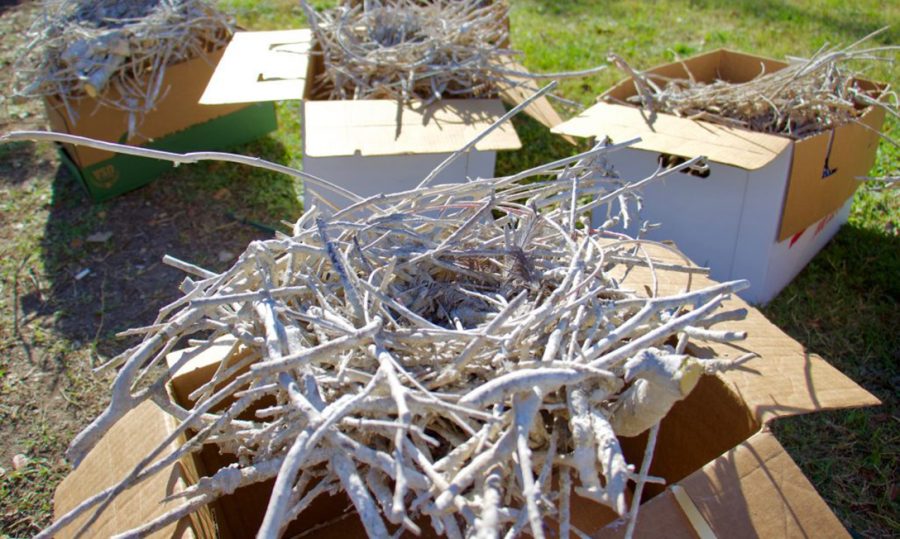
Attack at Elmendorf
Despite these gestures, all is far from well in the world of city-bird relations. And the tourists may notice in time that alongside a steep rise in landscape plantings with “native” explanatory signage downtown, something else is astir. Only a year before Nirenberg’s letter supporting Bird City certification, the City of San Antonio destroyed what was likely our oldest established rookery, based on dubious claims by Joint Base San Antonio that were subsequently amplified by the city.
Employees of Mitchell Lake Audubon Center took many of the likely hundreds of nests removed or destroyed in the off chance birds may one day discover and occupy them at their Southside preserve.
{For more on the Elmendorf removal, read Deceleration’s 2019 story “In Praise of Nuisance Heronries, Part One“}
Because all of the targeted birds are protected under the Migratory Bird Treaty Act of 1918, San Antonio’s Parks Department needed to gain federal clearance to remove the birds. In an August 2019 work order granted by the US Department of Agriculture, City Parks Department Assistant Manager Bill Pennell first listed the range of aggressive measures the park sought to use to drive out the birds of Elmendorf Park.
On the list of tools allowing the city to harass cattle, snowy, and great egrets, as well as cormorants, included “pyrotechnic[s], propane cannon[s]; firearms, mylar balloons, methyl anthranilate; drones, lasers, effigies, scare-man; nest/egg removal; trucks, dogs.”
We witnessed all but the firearms, dogs, and drones during the razing of Bird Island, all due to four collisions with cattle egrets at Kelly Field in nine years, allegedly linked to the roost at Elmendorf (out of roughly 500 wildlife strikes documented by the US Air Force at that airfield).
In one of her last meetings as a councilmember, former D5 elected Shirley Gonzales used her turn at the mic to try to tilt the Elmendorf story back in her favor. An early and consistent champion of the assault on Elmendorf, she now blamed the Air Force. “As you can imagine, the community had a lot to say about a program we were forced to do by the military,” Gonzales said.
But the City’s bird removal campaign didn’t stop (or begin) at Elmendorf. As far as we’ve been able to determine, chemical deterrents were first used at Brackenridge Park, with a sprayer attached to the older playground, as seen in the video below. And as revealed in documents recently obtained through an open records request, the city’s campaign of bird removal has since expanded to the entire park system.
“Prolonged presence in this area is not recommended.” City Parks at work in Brackenridge Park.
Chasing the Birds
In December of 2019, Pennell submitted to the USDA an expanded “work initiation document for wildlife damage management.” While the original project had covered Elmendorf’s “30 acres,” this new order authorized a project scope of 16,237 acres of territory — meaning the aggressive tools used at Elmendorf could be deployed across the city’s entire parks system.
Not long after, during the height of the COVID-19 lockdown in late March 2020, Deceleration was alerted to Parks/USDA targeting of birds along the San Antonio River in Southtown, five miles from Elmendorf and another mile further from the air bases at Lackland and Kelly Field.
Posting to NextDoor on March 31, 2020, a resident of King Williams warned neighbors that the City Parks Department and the USDA would soon be deploying “pyro type screamers to get [the birds] moved out.”
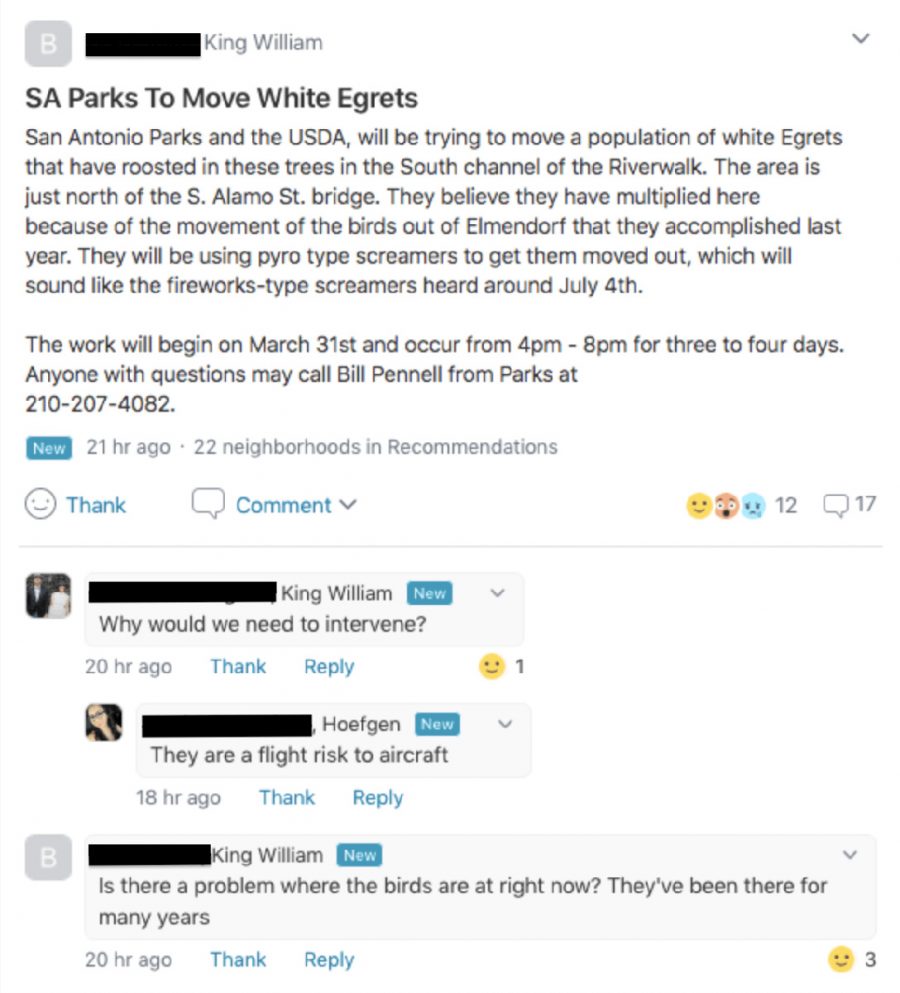
The poster added that city and federal officials “believe they have multiplied here because of the movement of the birds out of Elmendorf that they accomplished last year.”
On April 2, Deceleration documented USDA and City Parks staff in action, using lasers and bottle rocket-like pyrotechnics to harass birds over the San Antonio River from a bridge at the Blue Star Arts Complex. (A passerby observing us filming commented with incredulity, “Those birds are supposed to be here.”)
Local bird photographer Alesia Garlock has tracked the city’s displacement efforts through dogged on-the-ground investigation and regular open-records requests (which unearthed the above work orders), telling Deceleration that since Elmendorf, the city has been chasing, essentially, the same migratory birds around the city. And while egrets have long roosted in Brackenridge, her regular observations there as part of citizen science initiatives suggest that the numbers have increased over the last two years: “From Woodlawn [Lake], from Blue Star [Arts Complex in Southtown], from Nelson Brush area and who knows where else, a group of birds came to the trees [to roost] behind the playground at Brackenridge Park.” So if anyone wonders why their children haven’t had a playground to use there throughout our COVID-19 years, thank the forced eviction at Elmendorf.
But even before Elmendorf, the desire to drive migratory birds from Brackenridge was evident. For instance, an August 2019 ecological assessment of the park (PDF) conducted by UT’s Lady Bird Johnson Wildflower Center and released by the Brackenridge Park Conservancy urges stronger efforts to lure roosting egrets elsewhere (along with Brack’s famous feral cats, deemed “the worst invasive species in the world”).
As stated in this report:
“The park and zoo are employing harassment techniques to make the area less attractive for the rookery, with limited success. The next option would be to increase habitat value in a more appropriate location, while decreasing it in the current location by discouraging feeding, dislodging nests prior to egg laying and modifying the plant community.”
So here’s the rub. Whether through earlier attempts at seduction to better habitats or more recent campaigns of aggressive eviction, urban birds don’t do as they’re told.
Two years after their displacement from Bird Island, no egrets have come to occupy the nests relocated to Mitchell Lake Audubon Center. The nests have disintegrated, Deceleration was informed.
“It was an experiment,” one MLAC staff wrote us, “and it showed that you can’t make birds nest where you want them to nest, even if you give them a head start with a nest.”
Undoubtedly, the Parks Department’s efforts to dislodge nesting migratory birds around the city is a complicated one requiring further reporting, especially around water quality claims. But the ugliness of removal efforts witnessed to date show why San Antonio’s failure to address building strikes downtown — even as the City reaps accolades and potential new sources of revenue thanks to its Bird City designation — is worth watching.
The Chicago Study
Informed by decades of bird-strike data collected at the McCormick Place Lakeside Center on the shore of Lake Michigan, a June 2020 study gave a blast of supportive science to Lights Out efforts. It demonstrated clearly that building illumination matters: Simply turning off lights reduces building-related bird deaths by as much as 60 percent.
Since 1978, researchers in Chicago have collected roughly 40,000 dead birds at the base of the Lakeside Center. But the number of collections plummeted dramatically in 1999 when the building started regularly turning off lights at night. As these decades were also marked by plummeting bird populations nationwide, some of this decrease may be due to overall lower bird activity, the report notes. But the graphic cliff that appeared after 1999 presents an unmistakable and convincing divide. Bird kills per year plummeted from an average of around 800 in preceding decades to 200–300 in the span of a couple of years.
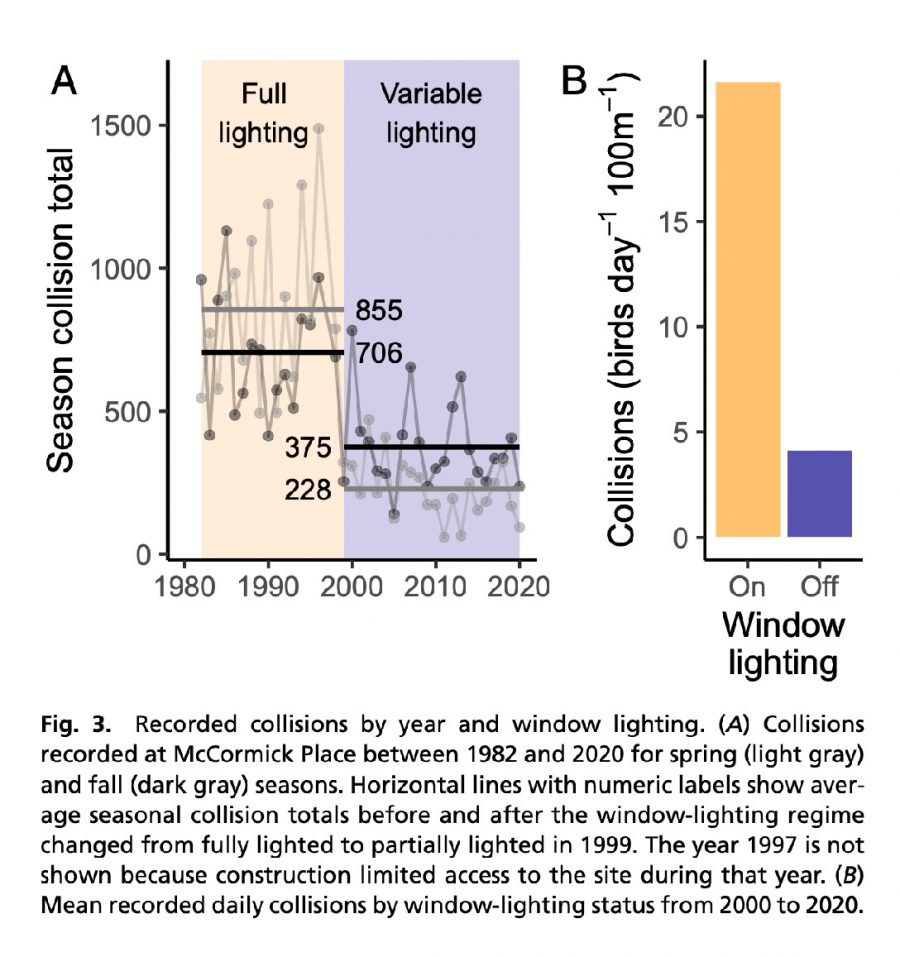
“Although our research focuses on a single site,” the authors wrote, “our findings have global implications for reducing or eliminating a critically important cause of bird mortality.”
One implication here for San Antonio is that, in the absence of city-level policy changes, actions by individual building owners (and even individual windows) matter.
“Our results certainly support a call for individual action in this regard, as darkening individual windows — especially those with obvious collision problems — is likely to make a meaningful difference,” Benjamin Van Doren of Cornell, one of the study’s authors, wrote Deceleration. “[Though] permanently darkening five windows that are particularly problematic for birds will likely have a much greater impact than darkening five random windows.”
The Chicago data also suggests that it’s time to move beyond the seasonal, high-migration-period, or rapid-response lighting practices of Lights Out and talk about permanent changes to our built environment in response to light pollution.
“Where possible, permanent lighting adjustments, such as downshielding lighting, changing lighting color, and automating the usage of window blinds between certain hours, will reduce the load on individual actors and decrease the risks posed to nocturnally migrating birds by light pollution.”
Lights Out, then, is less a destination than an inflection point.
As we make that transition, we must find each community’s “right windows,” so to speak. This process will almost certainly upset the city risk rankings of 2019 that has San Antonio positioned below Dallas, for instance. While Dallas ranks as the third most treacherous city for migrating birds, there is actually higher bird traffic in San Antonio, according to Van Doren. Dallas ranks as a more hazardous city because it covers three times the land area of San Antonio. “It’s important to keep in mind that these rankings only use information about city size, light output, and migration intensity to estimate the number of birds that may be exposed,” he wrote Deceleration. “We aren’t directly measuring the threat each city poses to birds, as that would be a lot more complex.”
It is into this complexity that Bexar Audubon in San Antonio and teams of volunteers around the county have waded by monitoring downtown city streets as a part of massive data collection effort known as the Lights Out Texas Monitoring Project.
Finding the Right Windows
Trying to understand why the San Antonio skyline was unchanged this fall in spite of the advance of so much science around building lighting and bird deaths, one of our first calls was to Bexar Audubon. A week later, I met a small team gathered in the pre-dawn light of a downtown parking garage. Audubon member Patty Pasztor used an orange origami bird to demonstrate to a small team of six the process of collecting victims and documenting bird strikes. Maps were distributed. Refreshers on using the iNaturalist app to punch in the pics and locations were offered. It would be one of their last surveys of the fall migration.
A Volunteer Protocol flyer provided to participants beforehand read: “The main objective of the Lights Out Texas-San Antonio Project is to monitor and document bird building collision casualties in downtown San Antonio during peak bird migration. This data will be used to influence building owners and managers to turn off unnecessary lighting between 11 p.m. and 6 a.m. during peak bird migration periods. Bird fatalities will be collected and used for scientific research.”
Similar efforts have been taking place across the country. Folks can view the local findings as they are posted on the Texas Lights Out Project page on iNaturalist.
We didn’t know it at the time, but the night we joined the group, October 21, was a few days after the “peak migration” for our area had passed, after which it’s estimated that half of all migrating birds will have passed through Bexar County. But migration, which generally lasts into middle or late November, is still well underway, with the potential for “large pulses of migrants” a reality yet, according to Colorado State University’s Kyle Horton, professor of conservation biology. CSU is a key contributor to BirdCast, a program that provides real-time migration imagery using radar, acoustics, and community science data to better understand migration movements and develop strategies to lessen detrimental human impact upon them.
The work has made rapid response by property managers on nights of high migration possible.
Here’s what 60 million birds look like streaming into Texas and the Gulf of Mexico well past our peak migration period, for instance:
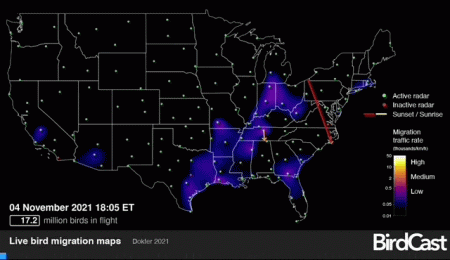
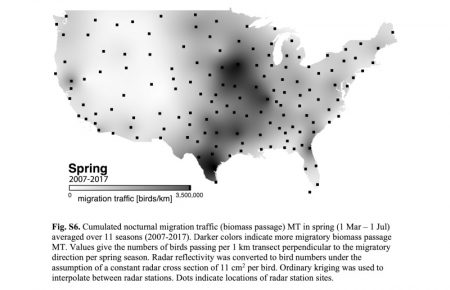
In spite of the moves made elsewhere around the country and across the state, San Antonio’s most prominent local birding advocates haven’t called for any lighting changes downtown or in city buildings. As they finalize their findings, it’s unclear if they will.
Rather than draw on national-level research like the Chicago building study and decades of related supportive research, Bexar Audubon wants to build their case upon the best local data they can gather personally, in spite of the challenges of working with an all-volunteer team with limited property access.
“With a lot of these buildings there are overhangs and balconies. We have lots of hotels,” said Bexar Audubon President Britt Coleman as we scan the landscaping across the street from the Aztec Theatre. “So if there‘s a bird strike that occurs higher up in the building, for us to find it, it has to fall all the way to the sidewalk. … It makes it a little bit of a challenge.”
And we’re not the only ones looking for victims.
“A lot of times cats or other animals will get to the carcasses before we do,” said Megan Vaupel, a volunteer from the Texas Master Naturalist program who joined the downtown search. “Even if we just find a pile of feathers we do record that, photograph that, take note of it.”
Coleman is hoping for two years of data to inform any recommendations the group may make to the city or area property managers. As they tabulate their findings for 2021, the group is actively talking about 2022.
“I want to make sure when we go before anybody in authority that we will be received as rational and thoughtful and not just somebody who is going off of emotions,” he said. “There’s enough of that already. And honestly it doesn’t do any good.”
When we reconnoiter inside the Grand Hyatt’s parking garage on the east side of downtown, a wing picked up at Frost Tower on the other side of downtown in a plastic bag is passed around. Images of the sole remains from the morning’s hunt are uploaded to iNaturalist with a note: “Wing with yellow at the shoulder. Possibly a meadowlark?” However, a staffer with Houston Audubon we speak to later suggests that wings that have been separated from the body like this indicate a hawk got hold of the bird, meaning it will likely not be counted as a building strike victim.
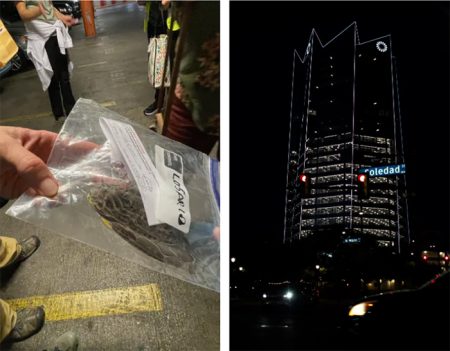
Bird Strikes, By the Numbers
Frost Tower is perhaps, our puffy morning eyes tell us, the second most clearly illuminated building downtown, behind only the Alamodome.
And, in fact, Frost Bank’s spokesperson said the bank was participating in Lights Out both in Austin and San Antonio.
“Frost is a tenant, not the owner, in both the main Frost Tower in downtown San Antonio and the regional HQ Frost Tower in Austin, so we usually defer to the building owners on questions like this,” said Bill Day, senior vice president of corporate communications. “However, Frost does take part in the Lights Out Texas program, where businesses dim or turn off outside decorative lighting on a seasonal basis to prevent harm to migrating birds.”
And yet all 12 floors of Frost Tower occupied by the bank have been fully illuminated from within on Deceleration‘s multiple inspections, including on the day I shadowed the Audubon crew. The external spines that etch the building’s outline clear to the Frost logo at the building’s apex were also fully lit.
It’s also a stand-out kill site.
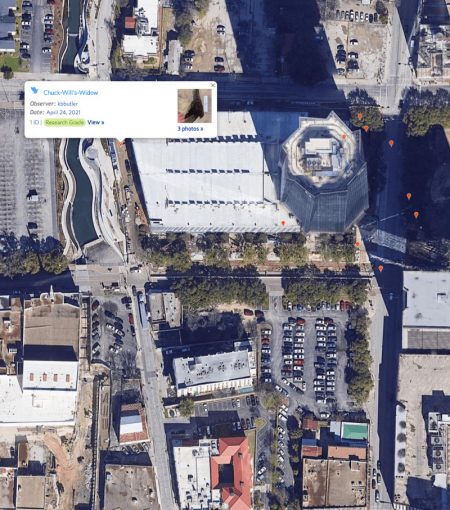
According to information supplied by Bexar Audubon, local volunteers collected 23 separate species on their spring and fall surveys. One out of every four birds discovered were white-winged doves (10). They were followed by grasshopper sparrows (3) and great-tailed grackles (3) for frequency. Less common birds, at least for inner-city denizens, included two painted buntings, a Chuck-will’s-widow, and a northern waterthrush.
Documenting one of those deaths with a photograph of a bird crumpled in the tower’s landscaping, iNaturalist user peterjoseph wrote:
“Bird looked like it crashed into glass of Frost Tower. Dropped on private property in Frost Tower property landscape. Could NOT retrieve until we got permission. It can be seen from the sidewalk. Looked like a dove (White wing Dove??).”
In spite of the low numbers overall, Frost Tower clearly stood out with one of every four dead birds found in its shadow.
For birds traveling south, Coleman says, Frost Tower is basically the first big glass building migrating birds would encounter when entering downtown. “Clearly that kind of structure is the kind that has the highest inclination of bird strikes,” he said.
In a distant second to Frost’s 10 birds, the Henry B. Gonzáles Convention Center clocked only three.
Coleman acknowledges the survey’s challenges.
“We weren’t always fully staffed every time we went out so there’s always a possibility that there was stuff we could have gotten that we missed simply because people weren’t at the right place at the right time,” he said. “One interpretation is that downtown isn’t quite as bad, certainly in comparison to Dallas and Houston.”
Of course, Galveston Island’s American National Insurance Co. building was just another untroubled landmark before it caught the attention of those hundreds of storm-weary birds in 2017.
There are no research partners among the downtown hotels, performance venues, or even the city’s downtown operations, whose thousands of staff are tasked not with finding and documenting bird strikes but shielding their guests from unpleasant sights. That means brooms at the ready, immaculate sidewalks, and well-picked landscaping in a city that floats on tourist dollars.
One city worker we met while making the rounds described how he keeps the birds that he finds and holds them in a freezer at his office. For who, or what purpose, was unclear. When asked about the comment, city spokesperson Kelly Saunders did not respond by press deadline. After directing Deceleration to the migratory bird resolution of 2020, Mayor Nirenberg’s Communications Director Bruce Davidson did not respond to multiple updates about this story’s key findings and invitation for comment.
In light of globally significant research like the Chicago study, it’s clear the value of Audubon’s volunteer effort is in helping expose where our city’s most dangerous windows are. But it would be wrong to use its findings, especially given the very real barriers to data collection, to make any claims contrary to what years of peer-reviewed science has spelled out clearly: buildings and night illumination are a deadly mix for migrating birds.
As the precautionary principle has long reminded us: absence of evidence for a particular problem does not equal evidence of absence.
Since 1970, bird populations in the United States and Canada have declined by 29 percent, or almost 3 billion birds, signaling a widespread ecological crisis. 3 Billion Birds video.
What If We Lived Like This Was Mass Extinction?
During the migratory bird resolution discussion in 2020, Councilmember Ana Sandoval emphasized the importance of responding to fast-collapsing bird populations by alluding to recent research, which has shown that total breeding adult bird populations in North America have crashed by 3 billion over the last 50 years — that’s one-third of all of the avian life on the continent gone. Culprits range from outdoor cats, habitat fragmentation and loss, pesticide and herbicide use, and lights and building collisions. This disturbing revelation was the product of a massive effort involving seven research institutions across the United States and Canada. Unpacking that numbing truth in The New York Times, the heads of the Cornell Lab of Ornithology and the Georgetown Environment Initiative stated that the findings suggest “the very fabric of North America’s ecosystem is unraveling.”
It’s not just rare birds that are “disappearing,” or birds known to be endangered or threatened, and thereby due some sort of state or federal protections. To the contrary, one of the more frightening elements of the study is that even our most common birds are in steep decline. While some species like the cattle egrets are thought to be growing in population today, birds of the heron family (Ardeidae) have collectively declined 28 percent since 1970 in North America, the researchers found.
Meanwhile, the global climate summit in Glasgow has been awash in pledges and counterpledges related to deforestation. The deep interconnections between industrial overheating of the planet and the biodiversity crisis are beginning to get shared time. As Leah Gerber, director of the Center for Biodiversity Outcomes at Arizona State University, bluntly told The Washington Post: “Nature is in a state of collapse.”
So, we’ve been asking ourselves while assembling this piece, what if we organized our lives and governed our city as if that were truly the case?
Knowing that, by one measure, dirty fuels are destroying birds at 30 times the rate of often-lambasted wind farms, would we tolerate a situation wherein the best public expressions of concern for fellow beings, such as our now-annual Monarch Butterfly and Pollinator Festival, accept sponsorship from Valero Energy — one of the largest climate offenders in the US that has, moreover, actively worked to prevent climate action?
Probably not.
For his part, Bexar Audubon’s Coleman struggles with questions of urgency while recognizing the severity of the issue far more than most.
“As San Antonio expands and grows the problem will only go in one direction: worse. Now would be a good time to be thinking about procedures and regulations we may want to consider to minimize bird strikes going forward,” he said.
So why delay action seeking a Lights Out proclamation?
“I don’t think we have a strong enough data set to be adamant with the city at this point,” he said, “but I do think we have data where we can have a meaningful conversation to set the agenda for deeper conversations as we go forward.”
Though the December proclamation seemed to suggest the city council would be amenable to an effort like Lights Out, Coleman is resistant to pressing them for policy change:
“I’m not going to initiate a jump-up-and-down campaign on something like this. There are a lot of things that deserve a jump-up-and-down campaign. But in my mind this isn’t one of them,” he said.
The hundreds of children stranded in the Texas foster care system without homes, he said, deserve such a campaign.
“That’s a jump-up-and-down problem. That’s super serious. This is super serious too because this is more insidious. It is slower and less obvious. The fact that our biodiversity is being damaged. The long-term consequences of that are horrid. It’s very very important. But where is its urgency in comparison with other issues? That is something that I struggle with. I personally consider it most important and urgent, but how do you communicate that urgency in the eyes of people who have to deal with life-and-death situations?”
But what climate and environmental justice mean — versus conservation narrowly — is that the way we treat our more-than-human relatives cannot be disentangled from how we treat our most vulnerable human relatives. That care is not a zero-sum game, in other words.
Lynn Cuny, the founder of Wildlife Rescue and Rehabilitation, suggests as much in describing her decades of work picking up the broken bodies left behind by bad development decisions. Her position as the Greater San Antonio’s region’s destination for injured wildlife — including dozens of injured and abandoned juvenile birds during the Bird Island demolition — has taken a toll.
She urged people to shift their focus “from the ‘face in the mirror’ to those other lives who live on this planet.”
“It remains a mystery to me how any non-human animal is left standing after the decades of pollution and all myriad assaults foisted on them by our self-centered lifestyles,” she told Deceleration. “The fact that climate change has not truly grabbed our attention tells me that nothing will.”
Likewise, for Rosie Torres, a dancer and choreographer involved with the Society for Native Nations and as a danzante with the Kalpulli Ayolopaktzin Azteca community, birds are family from an Indigenous perspective, a coequal branch in the created order. “Our feathered relatives are in peril,” Torres said. “From across Turtle Island, migratory paths are being distorted by air pollution, flight pollution, climate change, and urban sprawl. This little habitat in San Antonio is only a link in the chain. If we break this link, it’s only a matter of time before the ripple effects affect us.”
In such a world, turning off the damn lights at night is the least we can do. “It’s energy savings,” Audubon Houston conservation specialist Anna Vallery points out, in addition to the positive impact the Lights Out program has had on “birds, insects, bats … impacted by artificial light at night. To my mind there is no downside.”
